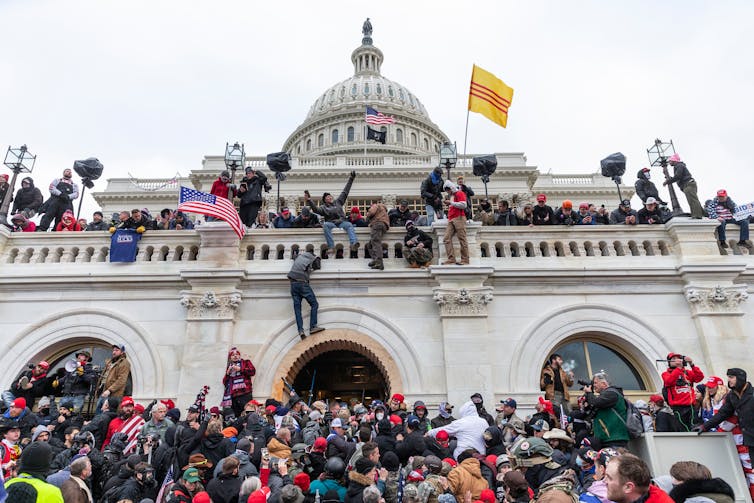Donald Trump’s rally at Madison Square Gardens in New York City on Sunday, October 27 was called a “carnival of grievances, misogyny and racism” by the New York Times. The event, which came just over a week before the election, was a hostile and partisan affair. Trump doubled down on his assertion that one of America’s gravest threats is from “the enemy within”.
Trump’s rhetoric is a manifestation of the increasingly polarised nature of US politics, whereby hostility from one group towards their perceived enemies is amplified across social media platforms. Yet Trump’s comment about an insidious “threat” hints at a darker undercurrent of division, with the threat of violence.
A June 2024 poll by the University of Chicago suggested that there was more support for violence against Trump than in his favour – 10% of respondents agreed that “the use of force is justified to prevent Trump becoming president”, compared to 6.9% who believed violence was justified “to restore Trump to the presidency”. Two months earlier, a Marist poll revealed that 47% of Americans believed that another civil war was likely in their lifetime.
As a report from Chatham House recently observed, the US is more divided “along ideological and political lines than at any time since the 1850s”. And according to another report from UK-based think tank, the Foreign Policy Centre, Americans have “increasingly grown to hate supporters of the other party, viewing their capture of political power as not merely unfortunate but illegitimate”.
Americans have regularly articulated a preference for living among people who share their political outlook. And they have expressed a stronger aversion to dating, living, working or socialising with supporters of another party. These views point to a state suffering the ills of sectarianism.
Those who have observed sectarianism around the world know all too well the chaos that such divisions can wreak. In the Middle East, for example, politically charged religious difference has had a devastating impact on political, economic and social life. Hundreds of thousands have been killed and millions displaced from their homes across Syria, Iraq, Yemen, Lebanon, Bahrain, Saudi Arabia, Iran and Libya because of violence along sect-based lines.
The US may be a long way from these scenarios, but there are some early warning signs. Competing forms of what American social theorist Irving Howe calls “epistemological authoritarianism” – or a sense of certainty that is zero-sum and rejects those of the other – can be easily seen across America’s political landscape.
Protests and counter-protests have played out both on the streets and online over abortion, gun laws and LGBTQ+ rights, as well as on university campuses over the war in Gaza. Elite entrepreneurs with political capital have also positioned themselves on opposite sides of sensitive issues to cultivate support.
Take, for example, Donald Trump’s false allegations that Democratic states executed babies after birth, or that migrants in Springfield, Ohio, have been eating pets. Such comments quickly spread across social media, regardless of their veracity. For Trump’s followers, truth matters less than the ability to justify their position on a particular issue. The stance taken by political communities is increasingly polemic and predictable.
Such dynamics are, of course, also shaped by local contexts. But the growing politicisation of social identities in recent years, and the increasing political importance of social issues, has created a landscape where difference is broadly antagonistic.
In this situation, grievance becomes a means of reinforcing in-group cohesion and disdain for the other. In such a landscape, society becomes divided into mutually distrustful camps set apart by a form of emotional polarisation that takes on political meaning.
It is the emotional dimension that is key here, as this is the foundation upon which political and social enmity is built. Supreme Court decisions, for example, relating to emotionally charged issues such as abortion, have strong mobilising potential on both left and right.
Entrenched differences
Elections often exacerbate uncertainty and division, as the 2020 US presidential election and its fallout demonstrate. According to Armed Conflict Location & Event Data (Acled), a research group that analyses occurrences of political violence around the world, demonstrations and far-right activity peaked around the 2020 election. This reached a crescendo with the events of January 6 2021 when Trump supporters stormed the US Capitol building.
Far-right activity has dropped during Biden’s administration. But a number of far-right groups have recently become active in the run-up to the election. Meanwhile, divisions over abortion, LGBTQ+ mobilisation, and the war in Gaza have contributed to a precarious environment.
Indeed, a vast majority do not think that next week’s election will solve the issues that America faces. In a recent poll, 70% of respondents believe that things in the US are going “in the wrong direction” – a view shared more by Republican respondents (94%) than Democrat respondents (41%). And 19% of Republicans think that if Trump loses the election, he should declare the results invalid and do whatever it takes to assume office.

The schisms across the US are real and the pieces are not easily put back together. Narratives of division will continue to spread as election fever increases, further deepening the rifts in American society. And sectarianism will become the broad frame through which political and social life is viewed.
This need not necessarily become violent. But it can easily become entrenched. The increasingly hostile exclusion of “the other” in all its forms, along with a growing willingness to breach established norms and rules, requires a step back from the brink before it is too late.
Simon Mabon receives funding from Carnegie Corporation of New York. He is a Senior Research Fellow at the Foreign Policy Centre in London.
This article was originally published on The Conversation. Read the original article.







